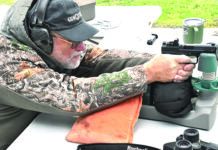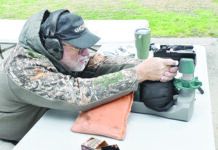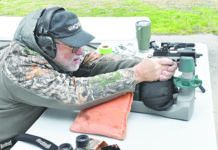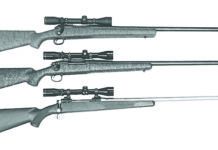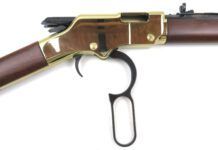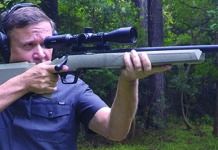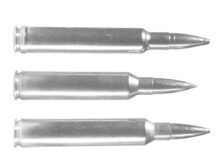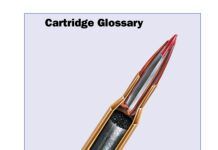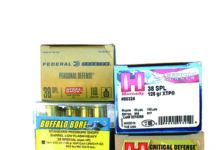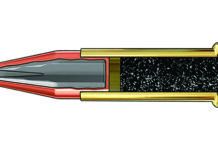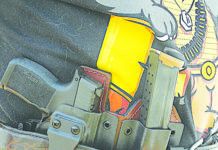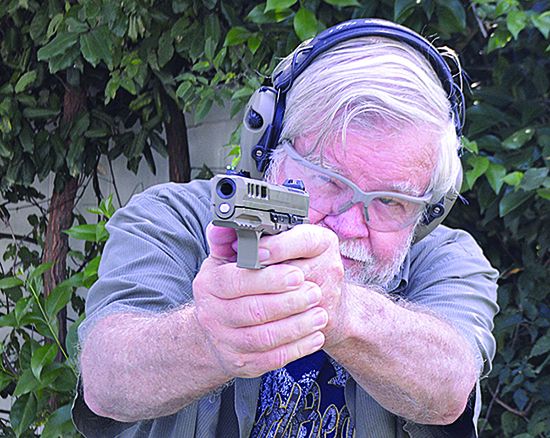The compensated 9mm seems more popular than ever, with Smith & Wesson, Springfield, and SIG offering pistols with compensators on the end of the barrel, mounted integrally in the slide, or as a simple cut out in the barrel. Most of us don’t consider the 9mm to be a hard kicker. Just the same, the addition of a compensator seems to be an important trend. Another movement finding favor is manufacturing a handgun with an aluminum frame as an alternative to the usual polymer-frame 9mm. The additional weight results in less recoil. In either case, the difference in speed shooting is noticeable because recoil is less.
In this shoot out we fire two innovations against each other. The first is Smith & Wesson’s Military & Police 2.0 Compact Performance Center gun. This is a polymer-frame compact 9mm with an integral compensator. Next is the Live Free Armory Compact AMP, short for Aluminum Match-Grade pistol. This is a Glock 19–size handgun with a 15-round magazine capacity. The AMP is also available in a long-grip AMPX version, which accepts 17-round magazines. The Live Free Armory AMP is similar to the Glock pistol, being basically a metal-frame 9mm version of the Glock 19 with certain innovations.
We have fired dozens of 9mm handguns, and we can say the pistols tested here are in fact light in perceived recoil and high on recoil-recovery control. We found one to be more comfortable to fire, while the other was faster in making follow-up shots. In the end, one pistol has the better features, while the other is a good pistol, but it’s not the top performer in this shoot out. Here’s how they did:
Live Free Armory Aluminum Match-Grade Pistol (AMP) Compact 51655131572 9mm Luger,
$639
Gun Tests grade: B-
The LFA AMP 9mm is a good shooter and offers light recoil. While it is a little heavier to carry concealed, some shooters will find the aluminum frame comforting. We would have preferred the grip frame had more adhesion and abrasion. It was dogged by failures to extract.
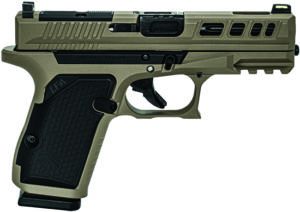
| Action | Semi-auto short recoil, locked breech striker fired |
|---|---|
| Trigger | Striker-fired double action only |
| Overall Length | 7.1 in. |
| Overall Height | 5.2 in. |
| Maximum Width | 1.275 in. |
| Weight Unloaded | 1.7 lbs. |
| Weight Loaded | 2.1 lbs. |
| Barrel | 3.9 in. long, 1:10 twist, nitride finish, match grade 45-degree crown, fluted |
| Capacity | 15+1 |
| Slide | FDE Cerakote-finished stainless steel |
| Slide Retraction Effort | 15.5 lbs. |
| Frame | Aluminum |
| Frame front strap height | 2.1 in. |
| Frame rear strap height | 2.75 |
| Grip | Lock grip, removable, aluminum |
| Grip Thickness | 1.25 in. |
| Grip Circumference | 5.75 in. |
| Front Sight | Fiber optic |
| Rear Sight | Square notch |
| Optics | RMR-cut slide |
| Trigger Pull Weight | 6.1 lbs. |
| Trigger Span | 2.75 in. |
| Magazines | (2) 15 round |
| Warranty | Lifetime |
| Telephone | (407) 891-1255 |
| Website | LiveFreeArmory.com |
| Made In | U.S. |
Like many other pistols in the modern striker-fired universe, the LFA AMP 9mm is a Glock 19–sized handgun. The primary difference is that the AMP uses a metal frame. The aluminum frame means that the AMP weighs 1.7 pounds versus 1.48 pounds for the Glock 19 with its polymer frame. Glock created a gun for everyone, a pistol with an uncomplicated manual of arms that serves moderately trained troops and police well, but that doesn’t limit a trained shooter. The popularity of the Glock cannot be overstated, but there is always room for improvement. A good rule for the Glock and Glock-like pistols is that handguns costing less than the Glock have had corners cut somewhere, while those more expensive than the Glock should be closely studied to see if their changes offer real advantages. A cottage industry offering Glock upgrades on a piecemeal basis eventually produced complete handguns based on the Glock, but vastly improved. As an example, we found Glock 19 pistols for $539, up to $588 with night sights. That isn’t much less than the Live Free Armory AMP. If you were to buy a Glock and add a standard rifled match barrel, fiber-optic sights, and an aluminum frame, you would have much more expense than simply purchasing a Live Free Armory AMP.
The AMP features a stainless-steel slide. The slide features nine lightening cuts, four of different sizes on each side of the forward part of the slide and one behind the front sight. These cuts serve reasonably well as forward cocking serrations. The rear serrations offer plenty of gripping surface. The muzzle end of the slide is beveled for easy holstering. The front post is a fiber-optic-equipped type. The rear sight is a tall blade with a square notch. The rear of the sight is serrated. The optics cut is a Glock type. The barrel is a modern fluted type with standard rifling. The muzzle crown is especially well done.
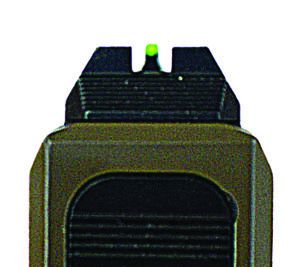
The pistol is finished in flat-dark-earth Cerakote. The frame is aluminum, adding weight to the pistol. The grip is more angular than the Smith & Wesson’s, and while the angle is 1911 like, the hand fit isn’t. The grip features synthetic grip panels. An extended beavertail or tang lowers the bore axis and offers greater recoil control. The frame features an accessory rail for combat lights or lasers. Both front and rear straps are serrated, but we would have preferred something more aggressive. The removable grips are only slightly pebbled in a honeycomb pattern. There is a finger-groove treatment beneath the trigger guard. The squared-off trigger guard isn’t serrated or checkered. When we fired the pistol, we discovered this relief under the trigger guard helps lock in the support-hand fingers. The magazine release is, we feel, an improvement over the Glock. Both the magazine release and slide lock are protected from bumps and inadvertent operation. There is a single slide lock on the left-hand side.
The trigger action is standard Glock. The trigger is flat, with the trigger breaking at 5.6 pounds. It is not particularly clean or crisp, but it compared well to Glock pistols on hand. Some Glocks were lighter on the trigger break, some a little heavier. We liked the Smith & Wesson Military & Police trigger much better. Takedown is Glock simple. The frame features a light rail for mounting combat lights. The internals appear to be standard Glock. It would be simple enough to add Glock-compatible aftermarket parts. Slide-to-frame fit is tight, with little lateral play.
Compatible with all Glock magazines, the AMP is supplied with two 15-round Magpul magazines, an FDE gun bag with instructions, and gun lock. We added Glock 17- and 19-round magazines to the mix.
With the pistol unboxed, we disassembled it and lightly lubricated it along the slide rails and barrel lock, as well as the Glock-specified single drop of lubricant on the connector.
We used two loads for combat shooting, the Fiocchi 147-grain FMJ and Federal Syntech 115-grain TSJs, firing a total of 100 rounds in this stage. We had to keep reminding ourselves we were not firing against a Glock, but then we have a lot of experience with the Glock 19, so comparison is inevitable. The AMP is controllable and offers light recoil. Felt recoil seems lighter than the Smith & Wesson. Compared to the Glock 19, the elephant in the room, the AMP’s kick is lighter. The LFA AMP pistol weighs 10 ounces more than a Glock 19 and about 8 ounces more than the S&W tested. The Smith & Wesson’s recoil impulse is slightly heavier; however, the compensator makes for a flat-shooting gun. Muzzle flip is actually more subdued than with the Live Free Armory aluminum-frame pistol. Both are good shooters. The AMP is simply more comfortable. However, we wished the LFA AMP pistol had more aggressive stippling or checkering for better control.
During the firing stage, we suffered a total of three failures to extract. There were no feed stoppages or short cycles, but three failures with the cartridge case left in the chamber and the round coming up from the magazine butting into the cartridge case in the chamber.
During the accuracy-testing stage, we fired the pistol with Federal Syntech 115 grain, Speer’s 124-grain Gold Dot, and the Hornady FlexLock 135-grain load. During the firing test, recoil was more noticeable when the pistol is braced in a rest. Just the same, the handgun was among the softest-shooting 9mm handguns we have fired. As for off-the-bench accuracy at 25 yards, the pistol was accurate enough and consistent with five-shot groups of 2.5 to 3.2 inches. Firing a total of 30 rounds for accuracy, 10 rounds of each of the three accuracy loads, we suffered two more failures to extract.
Our Team Said: We liked the way the pistol handled in combat shooting, for the most part. We really didn’t lose control, but we felt that the grip treatment could be better. We simply realized that with cold or sweaty hands, the grip treatment isn’t ideal. It would be simple enough to add a Talon grip treatment or skateboard tape to resolve this, but the pistol should have handled well as issued.
| 9MM LUGER RANGE DATA | ||
|---|---|---|
| Federal Syntech Range 115-grain TSJ | Live Free Armory AMP Compact | Smith & Wesson 2.0 Carry Comp |
| Average Velocity | 1110 fps | 1134 fps |
| Muzzle Energy | 315 ft.-lbs. | 328 ft.-lbs. |
| Smallest Group | 2.6 in. | 1.9 in. |
| Average Group | 3.2 in. | 2.2 in. |
| Hornady Critical Duty 135-grain FlexLock | Live Free Armory AMP Compact | Smith & Wesson 2.0 Carry Comp |
| Average Velocity | 1060 fps | 1065 fps |
| Muzzle Energy | 337 ft.-lbs. | 340 ft.-lbs. |
| Smallest Group | 2.4 in. | 1.8 in. |
| Average Group | 3.0 in. | 2.5 in. |
| Speer Gold Dot 124-grain GDHP | Live Free Armory AMP Compact | Smith & Wesson 2.0 Carry Comp |
| Average Velocity | 1120 fps | 1139 fps |
| Muzzle Energy | 345 ft.-lbs. | 357 ft.-lbs. |
| Smallest Group | 2.0 in. | 1.9 in. |
| Average Group | 2.5 in. | 2.3 in. |
We fired groups at 25 yards from a bench rest using an MTM Case-Gard K-Zone Pistol Rest. We used a Competition Electronics Pro Chrony to measure velocities. The first screen of the chronograph was 10 feet from the muzzles. TSJ = Total Synthetic Jacket. GDHP = Gold Dot Hollow Point.
Written and photographed by Bob Campbell, using evaluations from Gun Tests Team members. GT


